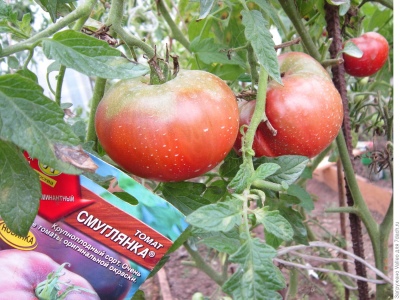
- Authors: Nastenko N.V., Kachainik V.G., Gulkin M.N. (Agrofirma Aelita LLC)
- Year of approval: 2015
- Category: grade
- Growth type: determinant
- Appointment: fresh consumption
- Ripening period: mid-early
- Ripening time, days: 110-115
- Growing conditions: for open ground, for film greenhouses
- Bush size: medium-sized
- Bush height, cm: 60-90
Currently, a great many varieties of tomatoes, different in color and size, have been created. Perhaps no other culture gives such an opportunity to create a whole rainbow palette on the garden bed, which will decorate the site and even be an element of landscape design. An interesting bright dark-fruited tomato Darkie can be a color accent of this picturesque composition.
Breeding history
The work on the creation of a new variety Smuglyanka was carried out by experienced breeding masters Nastenko N.V., Kachainik V.G., Gulkin M.N. is "Agrofirma Aelita".
Description of the variety
The Darkie Tomato belongs to determinant plants that grow no more than 60-90 centimeters in height. However, these are average indicators: on open ground it is closer to 80 cm, and in a greenhouse it can stretch up to one and a half meters. The length of the leaves is average, they are painted in a dark green tone. The culture has intermediate inflorescences.
The main qualities of the fruit
The fruits of the Darkie are an individual feature of the variety, and the main thing is the color. He's unusual. Until the berry ripens, it is green, with the same green spot near the stalk. But when the time of maturity comes, the fruits turn into a chocolate-brown wonder of a flat-round shape, with a slight ribbing. Moreover, the color varies depending on the growing conditions - it can be black-pink and chocolate.
On average, the mass of these amazing and beautiful tomatoes is 170-240 grams, there are also large specimens weighing 200-300 g. But if you want to grow huge fruits, you can start normalizing the ovaries in the brush to get giants of 600-800 grams. The number of seed nests can be different - 4, 5, and even 6.
Taste characteristics
Not many gardeners know that the dark color in vegetables is formed due to the high content of anthocyanin - a powerful natural antioxidant that will prolong youth and increase immunity. And the healing fruits of the Darkie, among other things, are distinguished by their wonderful taste: sweet, juicy, fleshy. Thin-skinned, medium density pulp. And it is not surprising that the main purpose of the salad variety is for fresh consumption - such vegetables can decorate any dish.
Ripening and fruiting
Fruiting of the Dark-skinned woman is medium-early. From the first germination to harvest, it takes from 110 to 115 days. Fruit picking can be done from July to August.
Yield
The described variety of Russian selection also has a fairly high yield. If the culture is grown under a film, then the probability of obtaining from 1 m2 of a garden to 7-7.5 kg of healthy and tasty tomatoes is quite high.
The timing of planting seedlings and planting in the ground
Growing technology of the Darkie seedling. In this case, the seeds are planted in the period from March 20 to April 10, at the stage of the appearance of the first two leaves, the sprouts dive, and the already hardened seedlings are transplanted into the ground from mid-May to June 5. At the time of disembarkation, the bushes should be 45-55 days old.

Growing tomato seedlings is an extremely important process, because it largely depends on whether the gardener will be able to harvest at all.All aspects must be taken into account, from seedbed preparation to planting in the ground.
Landing scheme
Plants of the Darkness are determinant, therefore, it is possible to place them on the plantation more compact. So, for 1 m2 of the garden, it is intended to plant 4-5 grown seedling bushes. The optimal layout is 50 x 40 cm.

Growing and care
When growing Darkie, the originators recommend removing side shoots and forming a bush into 2 stems. Despite the fact that the bushes are not very tall, the trunks need to be tied, as the fruits can be large and heavy, and the plant is likely to break under its own weight.
Practice shows that when grown outdoors, using fertilizing with potash mineral fertilizers, the fruits are noticeably sweeter, although their size will be smaller.
For large-fruited tomatoes, uniform watering is extremely important for growth, otherwise the berries will crack. Therefore, the Darkie should be watered regularly. If this is not possible, the solution may be to mulch the soil next to the trunk. This always helps to preserve whole fruits and smooths out the difference in temperature and humidity readings.




A plant needs different micronutrients at each stage of growth. All fertilizers can be divided into two groups: mineral and organic. Folk remedies are often used: iodine, yeast, bird droppings, eggshells.
It is important to observe the rate and period of feeding. This also applies to folk remedies and organic fertilizers.


Growing regions
Almost all regions of the country are recommended for growing Tomato Smuglyanka, from the Far East and Siberia to the center. And also it can be successfully grown in greenhouses in the north, northwest, in the Urals, in the Volga region. In the Volga-Vyatka region, TsChO, in the North Caucasus, it is possible to land in open ground under a film.

























































































